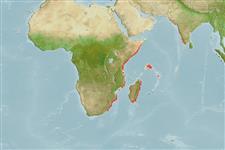Classification / Names
Nomi Comuni | Sinonimi | Catalog of Fishes(Genere, Specie) | ITIS | CoL | WoRMS | Cloffa
>
Kurtiformes (Nurseryfishes, cardinalfishes.) >
Apogonidae (Cardinalfishes) > Apogoninae
Etymology: Taeniamia: Name from feminine Latin noun 'taenia' meaning ribbon or band; and feminine Greek noun 'Amia' meaning a fish, often used with cardinalfishes genera. Here as Taeniamia referring to the vertical wide bars and near vertical to curved narrow bars as lines on most of the species in this genus.; flavofasciata: From the Latin word 'flavus' for yellow and 'fascia' for bar or stripe, referring to the dusky yellow bars on the body..
More on authors: Gon & Randall.
Environment: milieu / climate zone / depth range / distribution range
Ecologia
marino; distribuzione batimetrica 3 - 13 m (Ref. 54391). Tropical
Distribuzione
Stati | Aree FAO | Ecosystems | Presenze | Point map | Introduzioni | Faunafri
Western Indian Ocean: east coast of Africa from Mombasa, Kenya to Durban, South Afrcia, and Madagascar.
Size / Peso / Age
Maturity: Lm ? range ? - ? cm
Max length : 7.9 cm SL maschio/sesso non determinato; (Ref. 54391)
Short description
Morfologia | Morfometria
Spine dorsali (totale): 7; Raggi dorsali molli (totale): 9; Spine anali 2; Raggi anali molli: 12 - 14. Diagnosis: Color in life pinkish gray with about 7 dark-edged dusky yellow bars on the side of the body; the dark caudal spot round to slightly oval, about pupil size. Rays: Dorsal VI + 1,9; Anal II,12-14; Pectoral rays 14 (rarely 15). Gill rakers 5-7 + 15-16. Lateral-line scales 25+3-4. Median predorsal scales 6 (one with 7). Body depth 2.3-2.6 in SL; body width 2.3-2.7 in body depth; eye diameter 2.5-3.25 in head length; first dorsal spine 2.6-3.4 in second spine; second dorsal spine 1.9-2.3, and third dorsal spine 1.9-2.4 in head length; spine of second dorsal fin 2.2-2.75, and second anal spine 2.5-3.05 in head length; pelvic-fin length 4.2-4.75 in SL; caudal-peduncle length 4.45-5.2 in SL; distance from insertion of pelvic spine to anal-fin origin 4.4-5.25 in SL. Posterior preopercular edge usually fully serrate. Very small teeth 1-6 , usually present in a middorsal row posteriorly on tongue; extent of scaly sheath along anal-fin base at most moderately developed (Ref. 54391).
Found in seagrass beds in shallow water and was collected by trawl between 3 - 13 meters (Ref. 54391).
Life cycle and mating behavior
Maturità | Riproduzione | Deposizione | Uova | Fecundity | Larve
Gon, O. and J.E. Randall, 2003. Revision of the Indo-Pacific cardinalfish genus Archamia (Perciformes: Apogonidae), with description of a new species. Indo-Pac. Fish. (35):49 p. (Ref. 54391)
IUCN Red List Status (Ref. 130435)
Threat to humans
Harmless
Human uses
Informazioni ulteriori
StatiAree FAOEcosystemsPresenzeIntroduzioniStocksEcologiaDietaPredeConsumo di ciboRazione
Nomi ComuniSinonimiMetabolismoPredatoriEcotossicologiaRiproduzioneMaturitàDeposizioneSpawning aggregationFecundityUovaEgg development
Age/SizeAccrescimentoLength-weightLength-lengthLength-frequenciesMorfometriaMorfologiaLarveDinamica popolazioni larvaliReclutamentoAbbondanzaBRUVS
BibliografiaAcquacolturaProfilo di acquacolturaVarietàGeneticaElectrophoresesEreditarietàMalattieElaborazioneNutrientsMass conversion
CollaboratoriImmaginiStamps, Coins Misc.SuoniCiguateraVelocitàModalità di nuotoArea branchialeOtolithsCervelliVista
Strumenti
Special reports
Download XML
Fonti Internet
Estimates based on models
Preferred temperature (Ref.
123201): 24.4 - 27.8, mean 26.9 °C (based on 223 cells).
Phylogenetic diversity index (Ref.
82804): PD
50 = 0.5001 [Uniqueness, from 0.5 = low to 2.0 = high].
Bayesian length-weight: a=0.01479 (0.00690 - 0.03171), b=3.09 (2.91 - 3.27), in cm total length, based on LWR estimates for this (Sub)family-body shape (Ref.
93245).
Trophic level (Ref.
69278): 3.5 ±0.5 se; based on size and trophs of closest relatives
Resilienza (Ref.
120179): Alto, tempo minimo di raddoppiamento della popolazione meno di 15 mesi (Preliminary K or Fecundity.).
Fishing Vulnerability (Ref.
59153): Low vulnerability (10 of 100).
